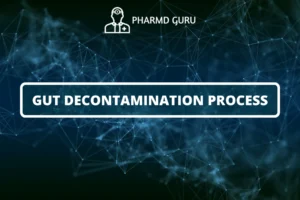Heavy metal poisoning with heavy metals, such as arsenic, lead, mercury, iron, and copper, can occur due to long-term exposure in various settings, including occupational and environmental sources.
SCROLL DOWN TO THE BOTTOM OF THE PAGE FOR ACTUAL NOTES
TABLE OF CONTENTS:
- Introduction
- Heavy Metal Poisoning
- Clinical Symptoms of Chronic Heavy Metal Poisoning
- Management of Chronic Poisoning
- 4.1. Diagnosis and Evaluation
- 4.2. Treatment Approaches
- 4.3. Chelation Therapy
- Prevention Tips
1. Introduction
Chronic poisoning with heavy metals, such as arsenic, lead, mercury, iron, and copper, can occur due to long-term exposure in various settings, including occupational and environmental sources. These heavy metals can accumulate in the body over time, leading to toxic effects. Recognizing the clinical symptoms and implementing proper management strategies are essential in addressing chronic heavy metal poisoning. This article discusses the clinical symptoms associated with chronic heavy metal poisoning and provides insights into the recommended management approaches.
2. Heavy Metal Poisoning
Heavy metal poisoning refers to the accumulation of toxic levels of heavy metals in the body. Prolonged exposure to heavy metals can occur through ingestion, inhalation, or dermal contact with contaminated substances or environments. Chronic exposure to heavy metals can have detrimental effects on various organ systems, including the nervous, cardiovascular, renal, and gastrointestinal systems.
3. Clinical Symptoms of Chronic Heavy Metal Poisoning
The clinical symptoms of chronic heavy metal poisoning can vary depending on the specific metal involved. Here are some common symptoms associated with chronic exposure to arsenic, lead, mercury, iron, and copper:
- Neurological Symptoms: Chronic exposure to heavy metals can lead to neurological symptoms such as cognitive impairment, memory loss, difficulty concentrating, headaches, tremors, and neuropathy.
- Gastrointestinal Symptoms: Heavy metal poisoning can manifest with gastrointestinal symptoms such as abdominal pain, nausea, vomiting, diarrhea, and loss of appetite.
- Renal Effects: Certain heavy metals, like lead and mercury, can cause kidney damage, leading to decreased kidney function, proteinuria, and abnormal urine output.
- Cardiovascular Effects: Chronic exposure to some heavy metals, particularly lead and mercury, can contribute to cardiovascular problems such as hypertension, increased risk of heart disease, and abnormal heart rhythm.
- Hematological Effects: Heavy metal poisoning may lead to abnormal blood cell counts, anemia, and impaired blood clotting.
- Skin Manifestations: In some cases, chronic heavy metal exposure can result in dermatological symptoms such as rashes, discoloration, and skin irritation.
These symptoms may develop gradually over time and can be nonspecific, making it challenging to establish a definitive diagnosis without proper evaluation.
4. Management of Chronic Poisoning
4.1. Diagnosis and Evaluation
Diagnosing chronic heavy metal poisoning involves a comprehensive evaluation, including the patient’s medical history, occupational history, and exposure assessment. The following diagnostic approaches may be employed:
- Physical Examination: A thorough physical examination, including neurological and dermatological assessments, can provide valuable insights into the possible effects of chronic heavy metal exposure.
- Laboratory Testing: Blood, urine, and sometimes hair or nail samples may be analyzed to measure the levels of heavy metals and assess organ function.
- Imaging Studies: Imaging studies, such as X-rays or bone scans, may be conducted to evaluate heavy metal deposition in the bones or organs.
4.2. Treatment Approaches
The treatment of chronic heavy metal poisoning aims to eliminate or reduce further exposure and manage the associated symptoms. Treatment approaches may include:
- Environmental Intervention: Identifying and eliminating the source of heavy metal exposure is crucial. This may involve modifying work processes, implementing protective measures, or relocating individuals from contaminated environments.
- Symptom Management: Treating and managing the specific symptoms related to heavy metal poisoning, such as neurological or gastrointestinal symptoms, is an important aspect of patient care. This may involve medications, dietary modifications, and supportive therapies.
- Nutritional Support: Adequate nutrition and supplementation, particularly with essential minerals and vitamins, can support the body’s detoxification processes and promote overall health.
4.3. Chelation Therapy
In some cases of severe heavy metal poisoning, chelation therapy may be considered. Chelating agents are administered to bind with the heavy metals in the body, facilitating their excretion through urine or feces. Chelation therapy should be administered under the supervision of a qualified healthcare professional and tailored to the specific heavy metal involved.
5. Prevention Tips
Preventing chronic heavy metal poisoning involves taking proactive measures to minimize exposure. Consider the following prevention tips:
- Occupational Safety: Adhere to proper safety protocols and use protective equipment when working in occupations with potential heavy metal exposure.
- Safe Practices: Follow safe handling procedures for substances containing heavy metals and ensure proper ventilation in work environments.
- Awareness of Environmental Hazards: Stay informed about potential sources of heavy metal contamination in the environment, such as contaminated water sources or soil, and take necessary precautions.
- Proper Hygiene: Practice good hygiene, such as thorough handwashing before meals and after handling potentially contaminated materials.
- Regular Health Check-ups: Periodic health check-ups can help detect early signs of heavy metal toxicity and allow for timely intervention.
ACTUAL NOTES




